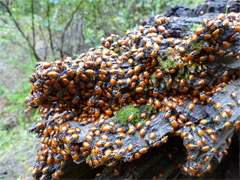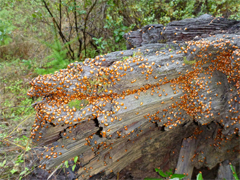Spawning Time in the Gualala
The Gualala River bar opens on November 29th!
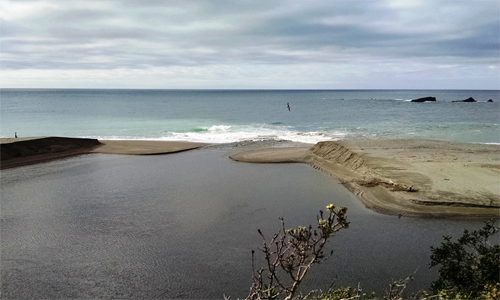
by Sean Case
Winter and early spring are always an exciting time for us, after all of the the past summer's hard work, we see the return of the adult steelhead. The young steelhead, that we see year round are beautiful but there is something special about witnessing a full-grown fish fresh from the ocean. During this time, we also see schools of large young steelhead getting ready for their first adventure into the Pacific.
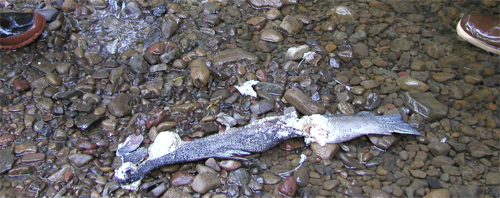
Our Spawner Survey Program has grown through the years with the addition of several new volunteers. We still have a couple of months to go, so if anyone is interested in participating please let us know, we would love to share this exciting time with more people.
Although we are still a ways away from our goal of estimating salmonid populations for the Gualala, the extra help is invaluable in building this program.
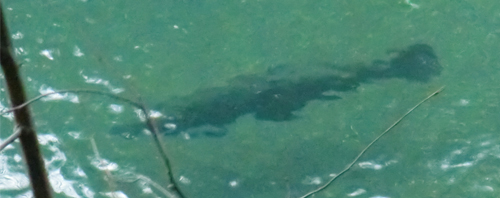
Sean Case is the GRWC Lead Scientific Technician and coordinates the Spawning Survey Program.
You can contact Sean at scase.grwc@mcn.org or phone the GRWC office at 707.884.9166.
GRWC Wins the NCRWQCB Stewardship Award!

From left to right: Roxane Chidlaw, GRWC Student Intern; Kirsten Sequoia, GRWC Coordinator; Sean Case, GRWC Scientific Technician; Bob Klamt, NCRWQCB; Henry Alden, Gualala Redwoods, Inc; Kathleen Morgan, GRWC Executive Director; Brian McFadden, NCRWQCB; Judy Rosales, GRWC Coordinator; Jim Burke, NCRWQCB
The North Coast Regional Water Quality Control Board (NCRWQCB) awarded the Gualala River Watershed Council with the 2013 Executive Officer’s Water Quality Stewardship Award.
"Over the past 20 years the Gualala River Watershed Council has promoted watershed restoration projects that have implemented the Gualala River Sediment TMDL, reduced erosion and improved stream conditions of the Gualala River Watershed, while also coordinating extensive landscape and water quality monitoring, providing quality data for the public to assess watershed recovery. On behalf of the California Regional Water Quality Control Board, North Coast Region we thank you for this outstanding work."
This is the first time the award has been presented in recent history and is given to an individual or group whose exceptional work has contributed to the preservation and enhancement of surface and groundwater quality.
Gualala Redwoods, Inc. and Henry Alden, Forest Manager of GRI, were also acknowledge by the Regional Board for their collaborative efforts and support of the Watershed Council’s work to restore the natural balance of the Gualala River Watershed.
Upcoming Workshops
When in Drought... Adapting to an Uncertain Climate
January 10, 2015
1:00 to 4:00pm
Gualala Community Center
more information...
Or contact the GRWC
707.884.9166
Backyard Biochar
Demonstration Workshop
Date to be announced
The Flow Bank Program
Installing Rainwater Catchment Systems
Date to be announced
A Threat to the
Gualala River...
New Zealand mud snails have infested the Russian and Garcia Rivers.
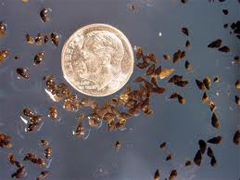 Let’s keep them out of the Gualala!
Let’s keep them out of the Gualala!
By The GRWC Interns
The New Zealand mud snail is an invasive species and is very easily spread; anything that touches water can carry them. Many common items are fishing gear, boats, waders, shoes, and monitoring equipment.
The snails can live up to 50 days in damp conditions.
There are ways to stop them however, the most straight forward being to freeze them. Putting gear or any other items that touched the water in a freezer for twelve to twenty four hours is enough to kill any attached snails.
Since the snails can often be so small they're very resilient, simply scraping gear off, or attempting to search out and get rid of the snails is not enough to remove all of them, and freezing gear is strongly encouraged.
Although they have not yet been found anywhere in the Gualala River Watershed, they are now commonly found in California, and are in the Garcia and Russian Rivers, so please be careful and freeze your gear!
Forest Management Plans in the Gualala
Interested in developing a Management Plan for your forest?
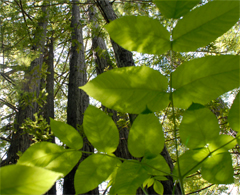
Funding is now available to develop Forest Management Plans through the California Forest Improvement Program (CFIP).
Landowners owning 20 to 5,000 acres of forestland can receive funding through CFIP for 90% of the cost of the plan.
An approved Forest Management Plan can lead the way to additional funding for site preparation, tree thinning, fuels management, erosion control and fish and wildlife habitat improvement on your property.
Contact Jill Butler at CAlFire
for more info...
email:Jill.Butler@fire.ca.gov
Tel: 707.576.2935
Jammin For Salmon
We have now placed over 700 logs and rootwads or 110 logging truck loads of wood back into the streams...
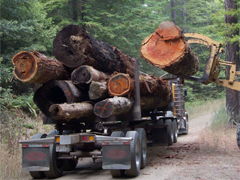
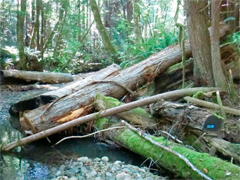
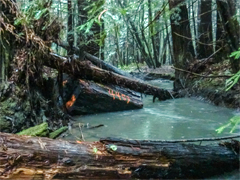
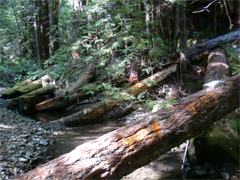
Funded by grants from the California Department of Fish & Wildlife
Gualala
Critter of the Month
Ladybugs
(cocconellidae)

